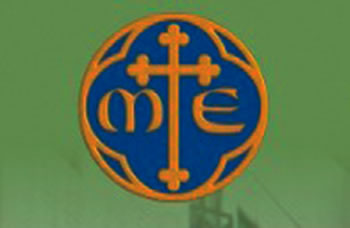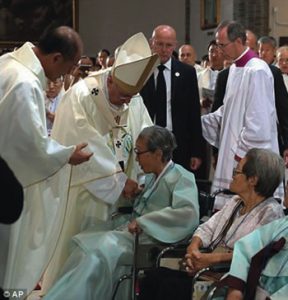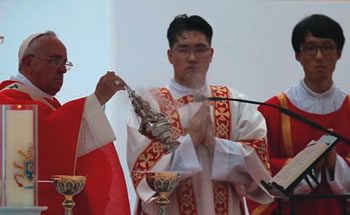A Spiritual Tsunami
From 13th to 18th August, 2014, Pope Francis went for the first time to Asia, on the occasion of the Asian Youth Days which were celebrated at Daejon, in South Korea. Those five days, very in-tensely organised, were distinguished by the beatification ceremony for 124 martyrs. The visit aroused a Catholic revival.
The Holy Father summed up his apostolic journey in three words: remembrance, hope, witness. The positive effects of this journey are already visible. Parish clergy have seen with astonishment – and also great joy – that many non-practising or occasionally practising Catholics, especially the young, came back to parishes from the Sunday following the Pope’s visit. Queues of penitents, including adolescents and young adults, were waiting at confessionals to receive God’s pardon; a step that many had neglected in recent years to devote themselves to video games, outings and studies.
Requests for entry into the catechumenate have multiplied, including on the Internet. In fact the various Catholic sites have been submerged with requests like: “What should I do to become a Catholic?” And many parishioners are no longer hesitating to commit themselves to serving the poorest people by offering their services in the various confraternities and associations that work for those whom this materialist society is abandoning at the roadside.
How can such a sudden regaining of fervour be explained?
Delicate gestures appreciated
The Korean people warmly welcomed the Pope, and, in return, they were very moved by the delicate gestures of the Sovereign Pontiff towards those whom he met during the five days of his visit. It could be said that Pope Francis succeeded in incarnating the Christian message, that of love and forgiveness, which constitutes the finest witness that the Church can give in Asia.
Here are some examples of that witness: the Pope received the relatives of the victims of the wreck of the ferry “Sewol” by wearing the yellow ribbon, the symbol of the relatives’ fight to know the truth about this tragedy and to get justice; he did not hesitate to baptise the father of one of the victims and, during the Mass celebrated in favour of reconciliation between the two Korean states, he greeted, one after another, some elderly women whom the Japanese had made slaves during the Second World War (the “comfort women”).
As well, mention must be made of the Pope’s visit to the “House of Hope.” which, at Kkottongnae, shelters about fifty physically and mentally handicapped children; as well as the prayer in the garden, scattered with dozens of white crosses, dedicated to children who were victims of abortion; and of course, the affectionate gestures he gave to refugees from North Korea who had fled from the Communist hell to get to Seoul at the cost of a real odyssey.
The face of Christ
So, in a concrete way the Pope showed what constitutes the heart of the Gospel message, and of his own mission as the Vicar of Christ. Like Jesus, and in his name, the Holy Father wanted to meet others personally – especially the weakest and most unfortunate – to announce to them the Saving Word, shown in the glorious Cross, the Word which leads to baptism, through gestures of mercy, which are those of Christ the Saviour. Indeed, through his gestures of love, the Pope conquered the hearts of many Koreans, who understood that in the light of Christian faith all people are worthy to be met and loved, forgiven, and so saved.
The Holy Father’s approach was clearly evangelical and missionary. He knew that he was visiting a country where triumphant capitalism, scarred by political and financial scandals, was bringing about a darkening of conscience with its structures of sin arising from an individualism which was grinding down the weakest. So he made himself the spokesman of Truth and Hope, that is, focussing attention on the most deprived, as much on the old, abandoned people, who only have the street to live on, as the young, enslaved to video games and studying for diplomas.
He encouraged the Korean bishops “to struggle against the temptation of prosperity” and “becoming a Church that was comfortable for the comfortable” which risked losing “its prophetic leaven.”
An envoy on mission
In the face of the plague of abortion, Pope Francis has made himself the defender of life and so of the family. He left a particularly fortifying message for the young people who were taking part in the VIth Asian Youth Days. The Holy Father exhorted them not to go to sleep in the arms of materialism and relativism, and he urged them to rise and go out to others so as to announce to them the joy of the Gospel.
In a country where the rate of suicides is one of the highest in the world, he presented the Gospel as “the antidote for the despair which seems to grow like a cancer in society which outwardly is materially rich, but which often experiences interior sadness and emptiness.”
So he is really an envoy on a mission. In recognising the dynamism of the Catholic Koreans (who presently number 5,000,000 against 200,000 sixty yeas ago, averaging 100,000 baptisms a year) the Pope set a goal so that this Church might continue its missionary work in Korea and, more widely, in Asia. So he encouraged the young people “to build a Church more holy, more missionary, more humble... A Church which loves and adores God by seeking to serve the poor, the abandoned, the weak and the marginalised...”
North – South: “one sole family”
Pope Francis did not dodge the painful question of the rupture between the North and the South of Korea, speaking to this divided people with the tenderness of a father. He left them this message: “You are only one family.” He wanted to touch the heart of each person, so that through dialogue, peace might be established on both sides of the barbed-wire curtain which still divides the two parts of Korea. To achieve that, he invited Catholics to show signs of the radical witness of forgiveness, by calling to mind the Cross of Jesus Christ, in which is revealed God’s power to resolve all hatreds and enmities, even those most obstinate. The Mass for peace and reconciliation celebrated in the Myeongdong Cathedral in Seoul, aroused great hope in the country. So it was confidence in the power of the Cross which was the final message the he addressed to the Korean people at the end of his visit.
Martyrs raised up as models
The climax of the Pope’s visit was the Mass of beatification of 124 Korean martyrs, in the course of which Pope Francis summed up, in a way, the message he had wanted to give the people of Korea during the five days. He left them models and intercessors: those faithful laypeople who began the evangelisation of their country, with this one key word : “martyr.”
This cloud of witnesses, to be added from now on to the 103 martyrs, Koreans and priests of the Paris Foreign Mission Society, already canonised by St John-Paul II in 1982, constitute the secret of the fecundity of the Church in Korea; that is, its growth and missionary dynamism. The Pope asked the faithful to take them as models of faith. He reminded them that the Christian is called to choose between Jesus, who is the truth and life eternal, and the world. Now, the martyr, who knows Christ’s warning (“The world will hate you because of me”(Cf John 15: 18 -20) chooses the Lord, and so also his Cross. “They were ready for great sacrifices and to let themselves be stripped of everything that could separate them from Christ: goods, reputation and honour, since they knew that Christ alone was their real treasure.”(Hebrews 10; 32 – 35). Pope Francis said it was a timely message because, in our time, the faith is put to the test by the world in various ways. He said: “We are asked to make compromises on the faith, to dilute the radical demands of the Gospel, and to conform ourselves to the spirit of the times. Yet the martyrs remind us to put Christ above everything else, and to see everything in this world in relation to him and his eternal kingdom. They challenge us to ask if there is something for which we would be ready to die.”
“The Pope Francis syndrome”
Yes, following certain journalists and observers, you can talk about the “Pope Francis syndrome,” because since 16th August, the date of the beatification, the number of pilgrims visiting the various shrines of the martyrs has grown by 30%!
In conclusion, let us return for a moment to the House of Hope at Kkokkongnae, and see how Pope Francis took leave of the Korean people by giving it his finest gesture of affection. Before leaving the sick children, the Holy Father turned towards a statue of the Blessed Virgin Mary, a statue like one that can be seen at the entrance to all the Catholic churches in this country (often the statue of Our Lady of Lourdes): he said a “Hail Mary” with them. Then, going out of the room, he put his hands above his head to form a heart with his arms, a powerful sign in Korea which means “I love you.”
(From “Missions Etrangeres de Paris” No 501, January 2015)
Translated by Fr Brian Quin sm




 Entries(RSS)
Entries(RSS)